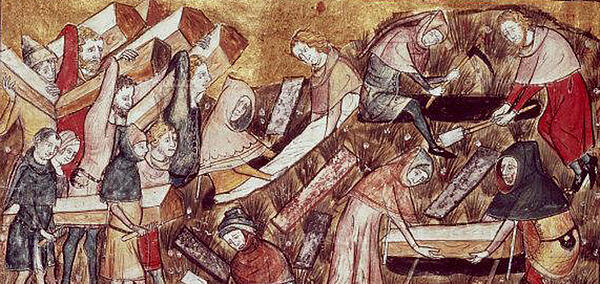The Black Death of 1348 to 1350
The Black Death was an infamous disease responsible for the death of 1.5 million people (out of an estimated four million) between 1348 and 1350.
Also known as the bubonic plague, the Black Death is thought to have been brought to England from Asia in 1348, affecting England on a total of seven occasions before the end of the 14th Century. However, none of them were as devastating as it’s first attack.
Medieval England did not have enough medical knowledge to handle the disease. Until recently, it was believed that the Black Death was the result of diseased fleas residing on rats in towns and cities, which injected people the disease when they bit into them.
However, a breakthrough in forensic science in 2014 found evidence that the disease was carried through the air, entering people’s lungs and spreading through coughing and sneezing. This would explain why England’s population were killed so quickly; by the spring of 1349, six out of 10 people living in London had succumbed to the disease.

An account of the impact the disease could have was provided by Giovanni Boccaccio, who lived in Florence during the time of the plague. An extract from a description he wrote in 1348 reads:
“This pestilence was so powerful that it spread from the ill to the healthy like fire among dry or oily materials. it was so bad that it could be communicated not only through speaking or associating with the sick, but even by touching their clothing or anything else they had touched. What I must say here is so strange that if I and others had not seen it with our own eyes I would hesitate to believe it, let alone write about it, even if i had heard it from trustworthy people. The pestilence spread so efficiently that, not only did it pass form person to person, but if animal touched the belongings of some sick or dead person it contracted the pestilence and died of it in a short time.”
According to this and other writings of the time, most victims of the Black Death were dead within three or four days. The spread was also incredibly rapid, due mainly to the living conditions in towns and cities at the time. Locals lived very close to one another and were unaware of contagious diseases.
Specifically, people did not realise that after a victim had passed away, the disease could still be spread to those who handled them without protection. Unable to understand how or why the plague was killing so many, people tried many different things to avoid their fate, including whipping themselves in a bid to gain forgiveness from God.
The plague did not discriminate between classes and positions, and this heavily impacted society. Particularly important were the deaths of working men, which meant fields weren’t being ploughed, harvests were missed and animals were going without care. This led to many rural villages facing starvation while food prices elsewhere rose up to four times, leaving peasants unable to eat.
Survivors of the Black Death considered themselves special, believing they were protected by God and should invest in improvements to their lives from then on.
The Black Death is also thought to have led to the Peasants Revolt. After the plague outbreak, lords encouraged peasants to leave their villages and work for them. However, the lords would then prevent them from returning home. This lead to many peasants finding better opportunities elsewhere, which upset the balance of the Feudal society that had kept peasants linked with the land.
The government tackled the problem by introducing the Statute of Labourers. This new law attempted to prevent peasants from travelling the country in search of better wages by declaring that no peasant could leave the village they belonged to and no lord could pay more than the wages paid in 1346.
While some chose to ignore the statute, many knew they must obey to avoid punishment. This eventually led to the Peasants’ Revolt in 1381, and as such many claim the Black Death was ultimately responsible for significant event in Medieval history.
See also: Cures for the Black Death
MLA Citation/Reference
"The Black Death of 1348 to 1350". HistoryLearning.com. 2025. Web.
